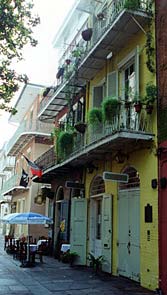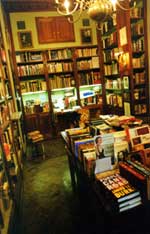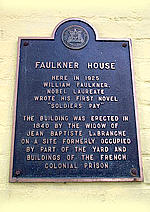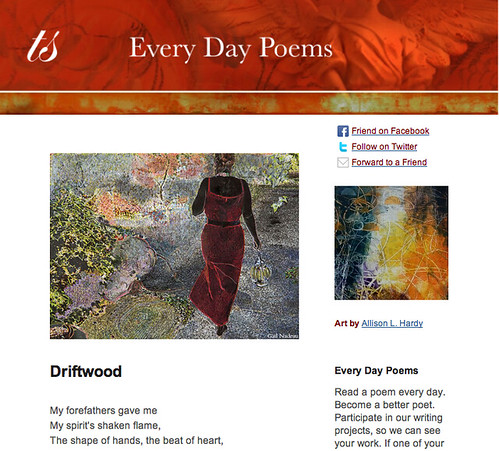In 1925 New Orleans, it was called Orleans Alley, more a broad walkway from Chartres Street and Jackson Square to Royal Street. On the east side of the alley was St. Louis Cathderal. On the west side was the Cabildo and then a group of three-story townhouses built on what had been part of the Cabildo’s jail yard. The Cabildo was the government building from which the Spanish (1767-1803) administered the territory of Louisiana (what would later be known as the Louisiana Purchase).
Today, the walkway is known as Pirates Alley, renamed not because pirates haunted the area but more because this was the place where pirates, including Jean Lafitte, were often jailed (Cabildo tours include the jail area, but it’s much changed from the original).
It was in one of those townhouses, 624 Pirates Alley, that a young writer from Mississippi lived for six months in 1925. He lived in the first-floor apartment; upstairs was an artist named William Spratling who did work for the New Orleans Times-Picayune. The writer lived there only six months, but it was sufficient to launch his literary career.
The writer was William Faulkner. During those six months of 1925, he wrote character sketches for the Times-Picayune; likely some poetry; and the draft of his first novel, Soldier’s Pay.

In 2005 after Hurricane Katrina, once we knew family members and friends were safe, my thoughts (and worries) turned to Faulkner House Books. I knew the French Quarter had been spared flooding, but I also knew the possibilities of wind and rain damage. As it turned out, the building did experience a leaky roof and some minor water damage. But the bookstore survived, and it came back.
Faulkner House Books is not Barnes and Noble; it is not Amazon. It’s contained within one large-ish room (likely the former drawing or living room) and a side hallway. Bookshelves in the main room extend floor to 16-foot ceiling. Faulkner first editions are behind the desk and chair where you make your purchases, but they’re on open shelves. In addition to Faulkner, the store specializes in Southern writers like Walker Percy, Tennessee Williams, Eudora Welty and Flannery O’Connor; modern first editions; and Southern and New Orleans literature and writing.
And poetry. Two former armoires house the poetry volumes. They’re located in the side hallway. They are my first stop at the bookshop. The hallway can accommodate two people at a time. Almost. The selection isn’t gigantic, but it larger than any poetry section I’ve seen at any Barnes and Noble. And it is focused on 20th century modern poets.
It wasn’t until my visit in March that I realized that Faulkner wrote poetry. In fact, he first saw himself as a poet. His first official work was a long poem entitled “The Marble Faun, ” and it was published about a month before he arrived in New Orleans (the volume is still available; it’s combined with another volume of poetry published in 1933 under the title of The Marble Faun and The Green Bough). Also still available is earlier prose and poems eventually collected and published in 1962 as William Faulkner: Early Prose and Poetry.
One critic has called Faulkner’s poetry “forgettable, ” but I find that unjust; it’s more formal than what we read today. Much of it is also love poetry, rather long love poems (The Marble Faun is one long poem, and The Green Bough is one poem divided into 44 sections). Here is an excerpt from The Green Bough, Section II:

Across the ceiling, down the farther wall
In cumulative waves, a golden river flowing
Above them both, down yawning dark to fall
Like some music dying down a monstrous brain.
Laxly reclining, he sees her sitting there
With firelight like a hand laid on her hair,
With firelight like a hand upon the keys
Playing a music of lustrous silent gold.
Bathed in gold she sits, upon her knees
Her silent hands, palm upward, lie at ease,
Filling with gold at each flame’s spurting rise,
Spilling gold as each flame sinks and sighs,
Watching her plastic shadow on the wall
In unison with the firelight lift and fall
To the music by the firelight played
Upon the keys from which her hands had strayed
And fallen.
New Orleans Sketches is comprised of 18 articles. The volume was first published in 1958, and republished several times since then (my edition is 2009). Several things about the volume are surprising.
First, the people Faulkner describes in a blend of fiction and non-fiction are recognizably “New Orleans” to me. They are people I have known, or like people I have known.

Third, I’m struck by how much these sketches read like Dashiell Hammett stories from the same period. One doesn’t expect Faulkner to read like tough detective Hammett, but the styles are similar and the action of the stories is similar.
I’m currently reading Soldier’s Pay, the novel he wrote in that first-floor apartment now occupied by the bookstore. It’s different from the novels that would later make him famous, but there are suggestions and hints of what was to come. It’s not considered in the same league as Erich Maria Remarque’s All Quiet on the Western Front, another novel to have come out of World War I and far more well known. But it is a good story, of a soldier returning home and likely dying from his war injuries. Faulkner is beginning to play with the theme of family and family relationships, and the dysfunction brought on families by the advent of modern life, and, in this case, war. (It’s also interesting from the perspective that author Sherwood Anderson, whom Faulkner met in New Orleans, encouraged him to turn to fiction.)
If you visit New Orleans, and you love books and literature, Faulkner House Books is likely the city’s most famous literary landmark. And if you go, make sure to see the poetry in the hallway.
Giveaway: I have a paperback edition of Faulkner’s New Orleans Sketches. If you’ve been to the bookstore, comment here about your experience by Sunday, April 13. Or if you haven’t, but have read Faulkner, comment here about what that was like (not everyone is a fan). Again, submit your comment by Sunday, April 13. We’ll select one comment at random to receive the book and announce the winner Tuesday, April 15.
Image by janafalk. Sourced via Flickr. Post by Glynn Young, author of the novels Dancing Priest and A Light Shining, and the just-published Poetry at Work (T. S. Poetry Press).
__________________
Want to brighten your morning coffee?
Subscribe to Every Day Poems and find some beauty in your inbox.
- Poets and Poems: Mary Brown and “Call It Mist” - September 18, 2025
- “Horace: Poet on a Volcano” by Peter Stothard - September 16, 2025
- Poets and Poems: The Three Collections of Pasquale Trozzolo - September 11, 2025

Maureen Doallas says
My kind of place, Glynn. Wonderful post. (It has been several decades since I was in New Orleans. I only vaguely recalling visited Faulkner House. Thank you for bringing it alive again.)
There was an item yesterday on FB that the Academy of American Poets has signed a deal with ing Features to bring daily poems back to newspapers and magazines. That made me happy.
Glynn says
That is great news about the newspaper/magazine deal! Thanks for the comment, Maureen.
Martha Orlando says
I took an entire English class on Faulkner and, though I haven’t reread him in years, he is still one of my favorite authors. O
Our class actually took a trip to Faulkner’s home place in Oxford, MS, and were treated royally by his nephew and his wife. It’s an experience I’ll never forget!
And, if I’m ever in New Orleans, I will certainly visit this bookshop.
Glynn says
Almost 25 years ago, we stopped in Oxford when we were returning to St. Louis from New Orleans, and it was specifically to see Rowan Oak. My wife took a picture of me and our two boys in front of it. I never intended to become a Faulkner fan, and it happened long after college. But it happened. Thanks, Martha.
Jeri says
The list of literary-related locales I’ve tours continues to grow, and this Faulkner location would be well worth a visit. My favorites so far have been London’s Wolf House location and Hemingway’s place in Key West. I’ve also seen where Hemingway was born in Illinois and where he committed suicide in Idaho.
Elizabeth marshall says
Jeri, welcome to Tweetspeak. So lovely to have you.
Signed,
Elizabeth, poetry barista @tspoetry
Part of the Tweetspeak team
Glynn says
Last September, I was able to visit the Charles Dickens house in London. I had to (sheepishly) admit that it felt like something of a pilgrimage. thanks for the comment, Jeri.
Harriett says
Nice tribute to Faulkner and his overlooked poetry — I guess it’s hard for these to stand next to his fiction.
I visited New Orleans for the first time in March myself. My nephew got married in a park near the French Quarter and we celebrated into the night at the Napoleon House. We stayed in Uptown and spent time at Audubon Park. New Orleans took me by surprise, but this is not the place to tell that story…
Thanks for this post too.
Rosanne Osborne says
Every year my favorite Faulkner novel seems to change. This year, it’s As I Lay Dying. Yet that’s not my favorite movie. It is interesting, though, with its split screens. Those screens capture the fractured narrative that diffuses Addie’s death, parts claimed by the walking dead.
Jane Davis says
Many thanks for the well thought-out post…our book group will be visiting New Orleans next March…we have already spent time on Faulkner and visited Oxford Rowan Oak the cemetery his houses etc…so this will be our first stop…look a literary tour of New Orleans when there in preparation–so enjoyed your post..thought you would enjoy this link: http://www.nytimes.com/2015/04/12/travel/12Cover-Literary-Louisiana.html